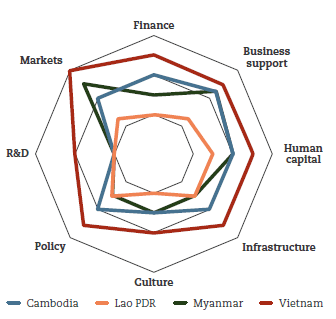Cambodia, Vietnam, Myanmar, and Lao PDR are the focus of the recently published #ClosingTheGap Mekong reports, commissioned by the DGGF (Seed Capital and Business Development programme). In collaboration with the Embassies of the Netherlands in respective countries, local stakeholders were consulted in a series of local workshops and provided their perspective on the strengths and weaknesses of entrepreneurial ecosystems and the best way forward.
DGGF’s #ClosingTheGap series was designed to improve the common understanding of key challenges faced by the “missing middle”, i.e. enterprises who have outgrown micro-finance but do not yet have access to regular financial services; by researching local entrepreneurs’ characteristics and needs, testing assumptions related to the current financial service offering and sharing insights as to their impact on the conduciveness of the overall ecosystem. Analysis of the enterprise data sets available reveal that the “missing middle” in the Mekong is made of the following types of enterprises:
Entrepreneurial culture
Across the region, (successful) necessity entrepreneurs account for the largest proportion of SMEs. As the region’s most developed country, Vietnam has the highest proportion of gazelles and moderate-growth businesses, followed by Cambodia and Myanmar. Lao PDR has by far the largest proportion of necessity entrepreneurs, reflecting its overwhelmingly rural and microbusiness-based economy.
If the entrepreneurial culture is getting popularised, local entrepreneurs operate in very different environments – with Vietnam relying on a more conducive ecosystem. The main barriers faced by local entrepreneurs are linked to small domestic markets and constrained export capacity; limited capacity to attract and retain qualified human capital; restricted acces to credit due to lack of credit information.

Opportunities to improve conduciveness
Opportunities to improve the conduciveness of local entrepreneurial ecosystems lie in i) improving and diversifying the offer of SME finance, including mobilization of local capital; ii) specializing and improving non-financial support to SMEs; and iii) fostering partnerships and collaboration.
More detailed recommendations specific to each ecosystem are outlined in individual country reports (in English) covering: Cambodia, Vietnam, Myanmar, and Lao PDR. The reports are also available in local languages.